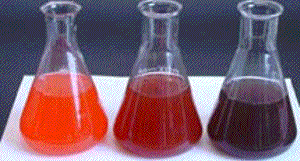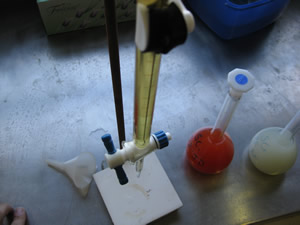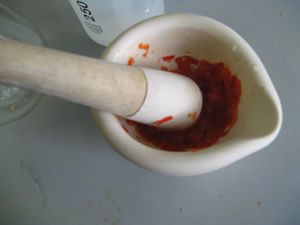Determination of Vitamin C
We can determine the vitamin C concentration of foods by a technique known as a redox titration. The vitamin C acts as an antioxidant and quickly changes iodine molecules to iodide ions. As long as there is vitamin C present the iodine will be converted to iodide ions. Starch is used as an indicator which turns blue in the presence of iodine.
When all the vitamin C in the sample has reacted with the iodine any extra iodine added will not be converted and remain to react with the starch to turn the solution blue.
The picture on the right shows three flasks of red capsicum. The flask on the left shows the original sample while the middle one shows the flask when all the vitamin C has reacted. The flask on the right shows the colour change when one more drop of iodine solution is added.

Equipment
Burette and stand
3 X 200 mL conical flask
10 mL pipette
Starch solution
Fresh red capsicum
Mortar and pestle
Iodine
Potassium iodide
100 mL beaker
Distilled water
White tile
Chux Wipes

Making the iodine solution (0.0005M) - This can be done by the laboratory technician prior to the class.
Weigh 0.200 grams of potassium iodide into
100 mL beaker. Add 0.13 g of iodine to the same beaker. Add 10 mL of distilled water to the beaker and swirl until the iodine crystals dissolve.
Transfer this to a 1 L volumteric flask and rinse the contents of the beaker thoroughly
into the volumetric flask.
Make the solution up to the mark with distilled water.
Making the starch solution - This has to prepared fresh and can also be done by the laboratory technician prior to the class.
Weigh 0.25g of soluble starch and add it to 50 ml of water at 90 oC in a 100 mL beaker.
Preparation of sample -
-
Cut, about, 50g sample of the edible portion of the capsicum and grind with a mortar and pestle.
-
Place the ground capsicum into a Chux wipe. Wrap the capsicum with the Chux and squeeze into the 100 mL beaker.

The titration method
1) Pipette 10 mL of the capsicum juice into a 200 mL conical flask and add about 50 mL of distilled water, 5 mL of 0.6 mol L−1 potassium iodide, 5 mL of 1 mol L−1 hydrochloric acid and 1 mL of starch indicator solution.
2. Titrate the sample with the potassium iodate solution. The endpoint of the titration is the first permanent trace of a dark blue-black colour due to the starch-iodine complex.
3. Repeat the titration with further aliquots of sample solution until you obtain concordant results (titres agreeing within 0.1 mL).
Using the above technique investigate questions such as:
- Does microwave cooking destroy vitamin C?
- Does exposure to air destroy vitamin C?
- Do frozen vegetables have as much vitamin C as fresh vegetables?
- Which fruit has the most vitamin C?
- Do cordials have as much vitamin C as an equal volume of fruit juice?
Investigate your own question by designing a fair test.